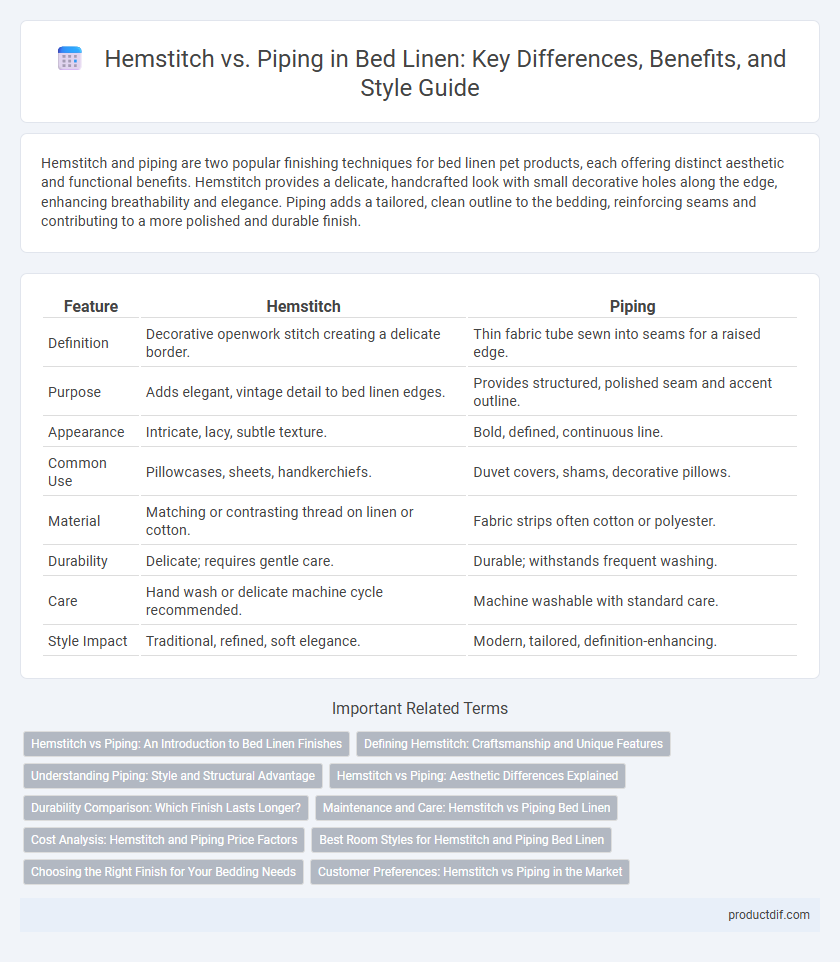Hemstitch and piping are two popular finishing techniques for bed linen pet products, each offering distinct aesthetic and functional benefits. Hemstitch provides a delicate, handcrafted look with small decorative holes along the edge, enhancing breathability and elegance. Piping adds a tailored, clean outline to the bedding, reinforcing seams and contributing to a more polished and durable finish.
Table of Comparison
| Feature | Hemstitch | Piping |
|---|---|---|
| Definition | Decorative openwork stitch creating a delicate border. | Thin fabric tube sewn into seams for a raised edge. |
| Purpose | Adds elegant, vintage detail to bed linen edges. | Provides structured, polished seam and accent outline. |
| Appearance | Intricate, lacy, subtle texture. | Bold, defined, continuous line. |
| Common Use | Pillowcases, sheets, handkerchiefs. | Duvet covers, shams, decorative pillows. |
| Material | Matching or contrasting thread on linen or cotton. | Fabric strips often cotton or polyester. |
| Durability | Delicate; requires gentle care. | Durable; withstands frequent washing. |
| Care | Hand wash or delicate machine cycle recommended. | Machine washable with standard care. |
| Style Impact | Traditional, refined, soft elegance. | Modern, tailored, definition-enhancing. |
Hemstitch vs Piping: An Introduction to Bed Linen Finishes
Hemstitch and piping are two distinct bed linen finishes that enhance fabric aesthetics and durability. Hemstitch involves creating small, decorative holes along the fabric edge by pulling threads, adding an elegant, handcrafted look ideal for classic or vintage bedding. Piping uses a narrow strip of fabric inserted into seams to create a raised, defined edge, providing a tailored and modern finish that reinforces the linen's structure.
Defining Hemstitch: Craftsmanship and Unique Features
Hemstitch in bed linen is a decorative technique involving precise hand or machine stitching that creates elegant openwork patterns along fabric edges, showcasing expert craftsmanship. This detail enhances breathability and adds a refined texture, distinguishing hemstitch from other finishes. Unlike piping, which uses a fabric-covered cord to outline seams for a structured look, hemstitch emphasizes intricate needlework for a delicate, artisanal appeal.
Understanding Piping: Style and Structural Advantage
Piping in bed linen enhances both aesthetics and durability by reinforcing seams with a narrow strip of fabric, often contrasting in color to add visual interest and definition. This technique provides a structured edge that resists fraying and maintains the shape of pillowcases, sheets, and duvet covers. Unlike hemstitch, which is primarily decorative, piping combines style with functional strength, making it a popular choice for premium bedding collections.
Hemstitch vs Piping: Aesthetic Differences Explained
Hemstitch features a delicate, openwork embroidery that adds a handcrafted, vintage charm to bed linen, enhancing texture and intricate detail. Piping, by contrast, consists of a narrow strip of fabric sewn into seams, creating a clean, defined edge that emphasizes shape and structure. These aesthetic differences influence the overall style, with hemstitch lending a soft, ornamental look and piping providing a crisp, polished finish to bedding designs.
Durability Comparison: Which Finish Lasts Longer?
Hemstitch bed linen features delicate hand-sewn or machine-made openwork stitching that adds elegance but may be prone to wear over time due to its intricate design. Piping consists of a durable fabric-covered cord sewn into the seams, providing reinforced edges that resist fraying and maintain shape longer under frequent washing. Overall, piping tends to offer greater durability compared to hemstitch, making it a preferred choice for bed linen intended for heavy use.
Maintenance and Care: Hemstitch vs Piping Bed Linen
Hemstitch bed linen requires gentle washing with mild detergents to preserve the delicate embroidered holes, avoiding machine drying to prevent fabric distortion. Piping on bed linen, often made from sturdier fabrics, allows for more robust laundering and can withstand machine washing and drying on low heat without losing its structural integrity. Proper care extends the lifespan of both, but hemstitch demands more meticulous maintenance to retain its intricate detailing, while piping offers practical durability.
Cost Analysis: Hemstitch and Piping Price Factors
Hemstitch and piping influence bed linen costs through different factors such as material, labor intensity, and design complexity. Hemstitch requires meticulous hand or machine stitching along fabric edges, increasing labor costs compared to piping, which uses pre-made fabric strips to create a defined border. Piping typically adds more material expenses but can be more cost-effective in mass production due to simpler assembly processes.
Best Room Styles for Hemstitch and Piping Bed Linen
Hemstitch bed linen complements traditional, vintage, and cottage-style rooms by adding elegant, handcrafted detail that enhances a cozy and timeless aesthetic. Piping bed linen suits modern, minimalist, and contemporary bedrooms, providing clean lines and subtle contrast that emphasize sleek, tailored decor. Choosing between hemstitch and piping depends on the desired atmosphere, with hemstitch enhancing warmth and nostalgia, while piping reinforces sharpness and sophistication.
Choosing the Right Finish for Your Bedding Needs
Hemstitch offers a delicate, decorative finish with fine hand-stitched holes that enhance the elegance of premium bed linens, making it ideal for classic or vintage styles. Piping provides a structured, reinforced edge with a narrow strip of fabric sewn into the seam, adding durability and a tailored look perfect for modern or casual bedding. Choosing between hemstitch and piping depends on whether you prioritize intricate detail and softness or robustness and defined lines in your bedding design.
Customer Preferences: Hemstitch vs Piping in the Market
Customer preferences for bed linen often vary between hemstitch and piping details based on style and durability. Hemstitch is favored for its delicate, vintage aesthetic and breathable design, appealing to those seeking elegance and traditional craftsmanship. Piping attracts customers looking for a modern, structured finish that enhances the linens' shape and provides greater durability over time.
Hemstitch vs Piping Infographic

 productdif.com
productdif.com